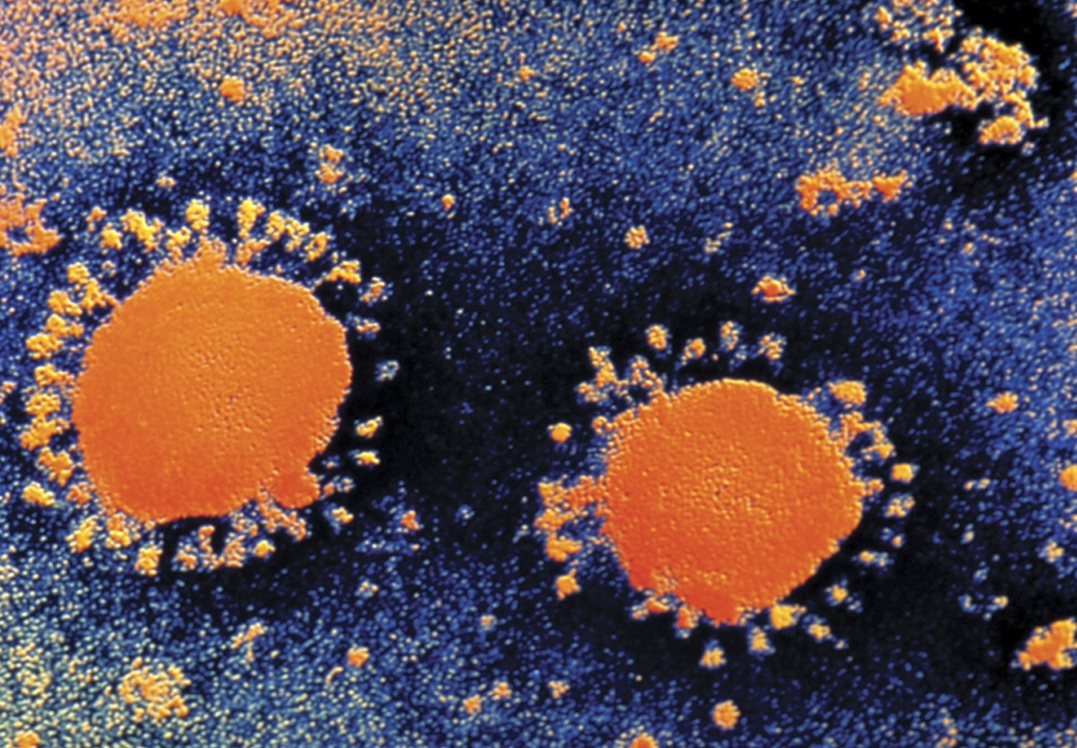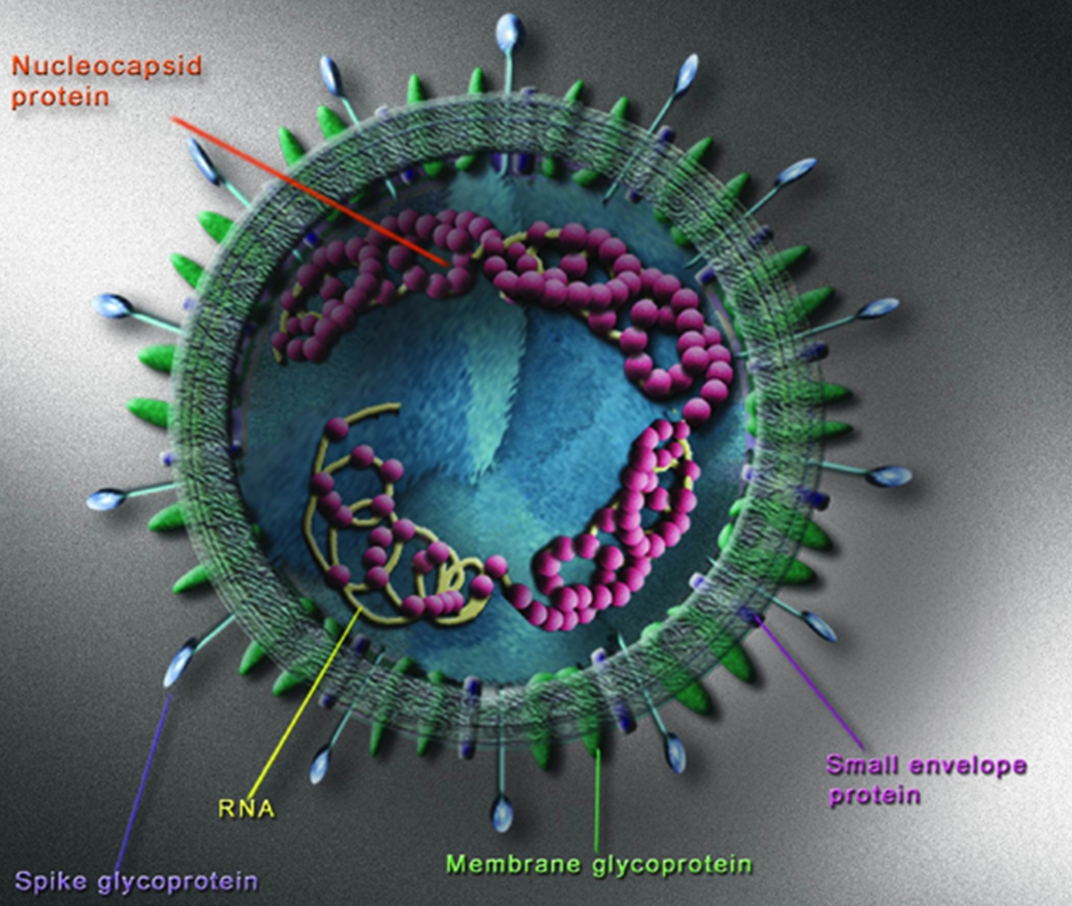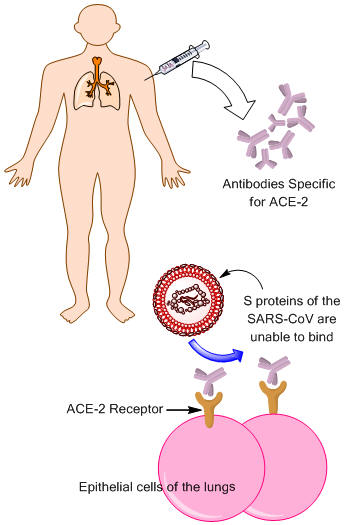SARS-CoVOverview: The severe acute respiratory syndrome-coronavirus (SARS-CoV) is a single-stranded, positive-sense, enveloped RNA virus that causes severe acute respiratory syndrome (Figure 1). The virion consists of a spherical capsid 80 to 120 nm (namometres) in diameter, and can be pleomorphic. It has a genome of approximately 29740 nucleotide bases enclosed within a helical nucleocapsid. The structural proteins of SARS-CoV include: the surface spike (S) glycoprotein, the membrane (M) protein, the small envelope (E) glycoprotein, and the nucleocapsid (N) protein (Wu et al., 2004) (Figure 2). The spike protein appears on the surface of the viral capsid or viral envelope, giving the virus a crown-like (corona) appearance when viewed under an electron microscope (Figure 1). The M protein has a cytoplasmic tail and short N-terminal ectodomain; there are only three M proteins on the membrane. The E protein is highly hydrophobic, while the S protein plays a critical role in the attachment to target host cells. Figure 1. This transmission electron micrograph reveals the 'corona' or halo appearance of two matured SARS-CoV particles. Figure 2. A model of SARS-CoV. Symptoms & Diagnosis: The SARS-CoV causes acute
infections. Infected individuals may
experience common symptoms such as: chills,
muscle rigidity, malaise, headache, Pathogenicity: SARS-CoV targets pneumocytes, enterocytes, and endothelial cells in the host's airways by manipulating ACE-2 (Angiotensin-converting enzyme) receptors, which are integral to the rennin-angiotension pathway. The virus uses the S protein as a ligand to bind to the receptor, which allows the virus to fuse with the host cell membrane, resulting in immediate infection. The S protein may also mediate pH-dependent endocytosis as an alternative entry mechanism. The exact mechanism in which SARS-CoV causes injury is still unknown; however, a three-stage disease model was proposed, illustrating that the virus acts in three phases: viral replication, immune hyperactivity, and pulmonary destruction. The lung is a major site of viral infection, where alveolar damage, epithelial cell proliferation, and macrophage concentration increase has been observed. It has been proposed that much of the inflicted pathogenicity is attributed to increased proinflammatory cytokine production as a result of the increase in macrophage recruitment. Infected individuals have been found to have lymphopenia, hemophagocytosis (lung), and white-pulp atrophy (spleen) which were all characteristic of influenza subtype H5N1. The infectious dose is unknown; however, it is proposed that a single viroid in the lungs may be enough to cause infection. Transmission: The primary route of transmittance is through respiratory droplets spread via sneezing and coughing, where the particles travel short distances to land in proximity of mucous membranes of the eyes, mouth, or nose. Likewise, contact of the eyes, mouth, or nose by hands previously in contact with infected surfaces or objects are also a common spread of the infection. It has also been found that the SARS-CoV is detectable in perspiration, and thus can be spread by individuals in contact with another individual who is perspiring or has perspired. This is why it is important to disinfect all gym equipment before and after use. Since there is no known vaccine, control of the pathogen would be to minimize and/or inhibit the routes of infection. Wearing medical face masks, minimizing contact with commonly touched surfaces or objects, and wearing latex gloves when in public can greatly reduce the risk of infection; other control measures, such as elimination of hospital transmission via enhanced infection-control methods have been utilized to control pathogenic outbreaks. There have been developments of potential vaccines that target and neutralize the S protein to prevent attachment of the virus to host cells (spike-specific monoclonal and polyclonal antibodies) (Figure 3). Figure 3. Spike-specific monoclonal and polyclonal antibodies preventing the uptake of the SARS-CoV by binding to ACE-2 receptors and antagonizing the viral-mediated response. References: Cameron, M.J., Bermejo-Martin, J.F, Danesh, A., Muller, M.P., & Kelvin, D.J. (2008). Human immunopathogenesis of severe acute respiratory syndrome (SARS). Virus Research, 133(1):13-9 Nicas, M., Harrison, R., Charney, W., & Borwegan, B. (2004). Respiratory protection and severe acute respiratory syndrome. Journal of Occupational and Environmental Medicine, 46(3): 195-197 Weiss, S.R., Navas-Martin, S. (2005). Coronavirus pathogenesis and the emerging pathogen severe acute respiratory syndrome coronavirus. Microbiology and Molecular Biology Reviews, 69(4): 635-664. |



